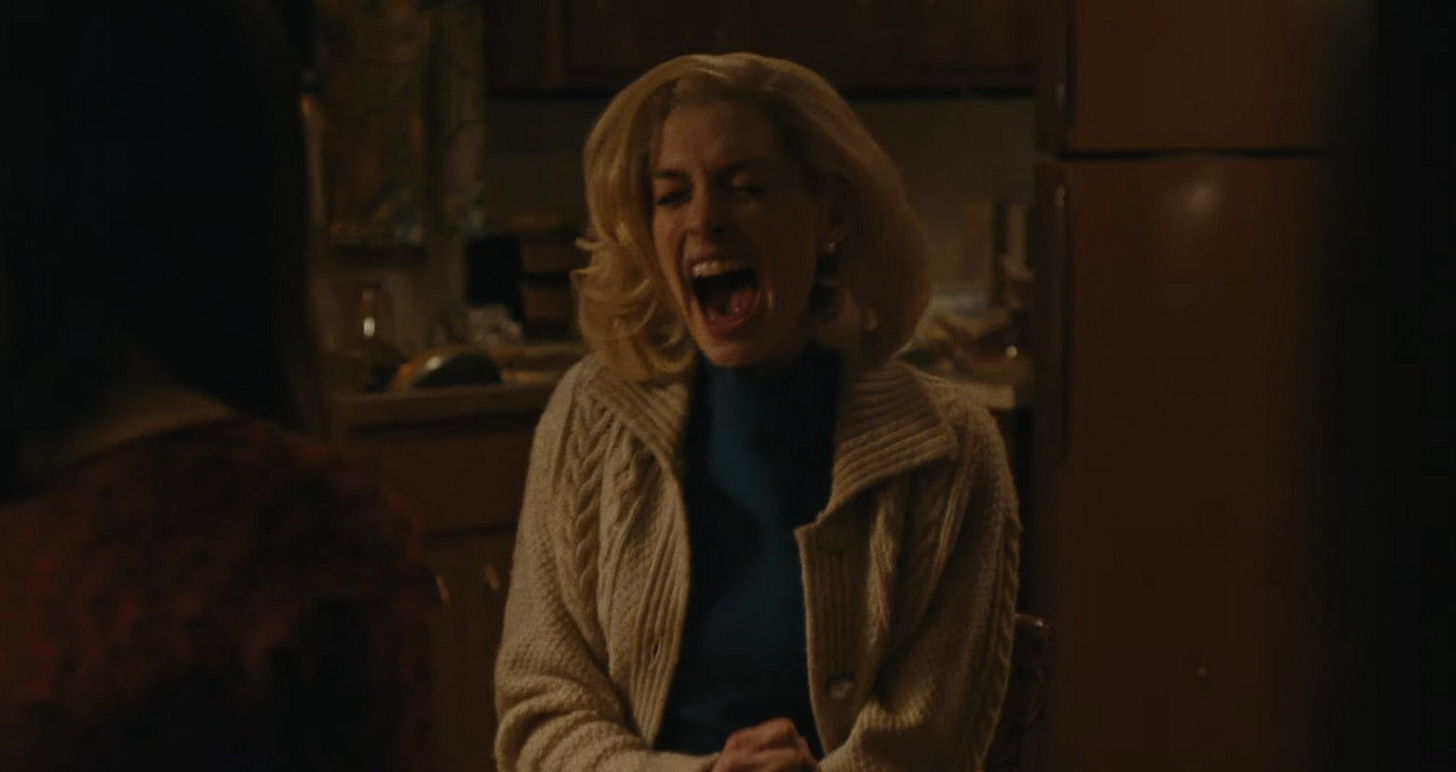Review: Hello, my Christmas Angel
Sure, William Oldroyd’s ‘Eileen’ is like ‘Carol’...if ‘Carol’ were rotted and vile
The Yearning Rating: ✰✰✰½
Romance: ✰✰✰
Sex: ✰
Storytelling: ✰✰✰✰
Performance: ✰✰✰
Yearning: ✰✰✰✰✰
Engaging with this post in any way is a huge help to us — and we’re not above begging :)
Don’t worry, we’re keeping the spoilers light!
Written by Ali Romig
I hear us sapphics are looking for a new Christmas film to call our own, disenchanted with the latest festive fare (it’s okay Happiest Season, you did your best—and with a few tweaks, you could’ve been iconic). While we’ll always have Carol to fall back on (more on Ms. Aird later), may I suggest giving Eileen a chance? William Oldroyd’s latest feature is for those chaotic queers who know that the holidays aren’t all about eggnog and cheer. Sometimes, they’re about obsession, family trauma, and painful-seeming masturbation.
In all seriousness, Eileen may not be the film your family snuggles up on the couch to watch Christmas night—no matter how chill they are!—but this unsavory, properly-dark story does unfold over the few days leading up to Christmas in 1964. Set in New England, in a town fittingly called X-Ville, the neo-noir psycho-sexual thriller follows twenty-four year old Eileen Dunlop (Thomasin McKensie), a graceless juvenile detention center secretary. Her days are unfulfilling, as she shepherds herself from her cruel job (the cruel nature of which she seems perfectly fine with), to the liquor store, to home, where verbal degradation at the hands of her emotionally abusive father awaits her. The car she drives is broken, and fills with exhaust while running, forcing her to ride with the windows down in the dead of winter. Her only solace is the sometimes violent, sometimes sexual—oftentimes both—fantasy world she dissociates into.
Then, like a misplaced jewel, Dr. Rebecca Saint John arrives at the prison, click-clacking her way into Eileen’s heart. Rebecca (Anne Hathaway in her best Lana Turner drag) dazzles in an otherwise beige-washed world. Her vibrant red, tailored suits and bouncy blonde blowouts look almost costume-ish next to the gray-faced townies—Eileen included. Not only does she stand out visually, but she also has different ideas about how things should be done. A child psychiatrist, Rebecca dislikes many of the harsher practices at the prison. It’s worth noting that Eileen seems either okay with—or numb to—this same harshness. Eileen quickly falls under Rebecca’s spell—if not for her compassion, then for her tenacity. For Rebecca’s part, she seems to enjoy the timid-seeming Eileen’s attention and takes her under her wing. The two quickly form an uneven yet thrilling friendship. Those violent fantasies I mentioned earlier are misinterpreted by Rebecca as “wonderful dreams,” and this underestimation of Eileen’s true nature kicks off a twisty, unforgettable third act.
Eileen is based on Ottessa Moshfegh’s award-winning 2015 novel of the same name. Moshfegh also served as one of the screenwriters for the movie, which may be why it’s such a faithful interpretation, albeit with a few key differences. I (rather predictably) read the novel as soon as I heard that the movie was potentially sapphic. My overall sense after finishing the book was that it was “not-quite queer.” In the movie, Eileen’s fascination with Rebecca is played as instant and singular, but the novel-version of Eileen is prone to obsession. She nurtures a toxic infatuation with a male co-worker for years before Rebecca comes into play, oftentimes sitting outside of his house at night and watching him. Could she be a bisexual disaster? Sure. But when reading the book, we get a sense that these delusions are tangled up in her need for escape, rather than in any sort of grounded or honest desire. What the book keeps vague and up for interpretation, the film presents as definitive: Eileen is in love with Rebecca. So while the actual plot is quite similar beat by beat in both formats, this shift ends up changing the movie-watching experience completely.
Even with this added declaration of love, Eileen is no romance. If you are online and sapphic, then chances are you’ve seen the early buzz comparing Eileen to Todd Haynes’ 2015 masterpiece, Carol. Listen, I get where this came from. Both films feature an older, blonde bombshell, and a younger, shier brunette. Both films take place over the holidays, in the mid-century Northeast. Both films feature a woman’s name as the title. But let me tell you, definitively, right now: if you go see Eileen expecting anything close to Carol, you will be disappointed. There are numerous differences between the two, but I think they can be accurately summed up using just one word. Ugliness.
Intentional ugliness permeates every inch of Eileen, whereas Carol is famously “not ugly.” Where Carol is soft and sensual, Eileen is hard and raw. Where Carol is refined and subtle, Eileen is inelegant and jarring. Where Carol is vulnerable, Eileen is pathetic. This ethos of ugliness is evident in not only the story, but the actors' performances. Both Hathaway and McKensie are strong and showcased well. As Eileen, McKensie is suitably unnerving as she bumbles through the film wearing only her dead mother’s clothes, all of which are two sizes too big. But there’s something in Hathaway’s portrayal of Rebecca that asks you to pay closer attention. At first, I thought her performance was a little obvious—I felt that I could see her acting. But as the story continued to unfold, I recognized that this was carefully designed. Underneath the curated glamor, Hathaway exudes a kind of frenetic instability. Her allure begins to take on a garish undertone, even as you remain attracted.
As a whole, the viewing experience is unpleasant. I don’t mean to say that the movie is bad, or not well done, but that it is literally hard to watch. A focus on unsightly realities is a major theme. We watch blood gush, vomit spew, and snot drip. We witness as the characters endure subtler indecencies as well—a cutting remark or insult to their very humanity. Every frame is awash in a dingy, dirty griege. The town itself is covered in a layer of brown, day-old snow. The music is dissonant, classically noir, and it crescendos unexpectedly, catching viewers off-guard. Its absence in certain scenes is just as loud. This culmination of overwhelming nastiness only intensifies the viewer’s unease, building to a “uhhh, what now?” moment that successfully flips the film on its head.
Eileen has more than a few aces up its sleeve, and because I’d read the book, I was unfortunately anticipating all of them—but that didn’t make the 90-minute ride any less visceral. Unless you’re a real lit-head (subtle brag, hah), I’d recommend you go into this one without too much prior knowledge. My friend who I saw this with was watching with fresh eyes and was properly gooped and gagged (and also fairly disgusted!). It may be tempting to describe this film as one about women subverting expectations in a time period where their choices were limited, but I think the story is far darker and more complicated than that—and that is really what makes it worth the watch.










